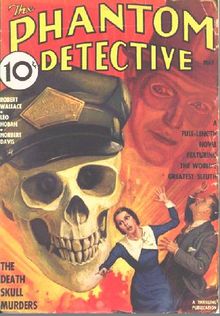The Phantom Detective
The Phantom Detective was the second pulp hero character published after The Shadow. The first issue was dated February 1933, a month before Doc Savage - March 1933. The title continued till 1953, 170 issues. For the character pulps, this is the third most issues after the Shadow (325) and Doc Savage (181). In western titles, Texas Rangers would have around 212 issues of their main character, known as the Lone Wolf.
The publisher was Ned Pines' Thrilling (also known as Better or Standard) Publishing. Ned Pines had a comic book imprint, which collectors usually refer to as Nedor Comics and The Phantom Detective had a series in their title Thrilling Comics.
Stories were credited to several pseudonyms. The first eleven Phantom Detectives were published under the Better house pseudonym of "G. Wayman Jones", and were largely written by D. L. Champion, a.k.a Jack D'arcy. The rest were under the pseudonym "Robert Wallace". These were largely written by Edwin V. Burkholder, Norman Daniels(36+), Anatole F. Feldman, Charles Greenberg, George A. MacDonald, Laurence Donovan and C. S. Montanye. Lesser contributors included Paul Chadwick, Norvell W. Page, Paul Ernst, Emile C. Tepperman, Henry Kuttner, Ray Cummings, Ralph Oppenheim and others. Ryerson Johnson is credited with #46, The Silent Death.
There have been several reprints of stories over the years. The most were by soft porn publisher Corinth Books, which did about 20 titles.
The Phantom (as he was called in the stories) was wealthy Richard Curtis Van Loan. In the first few issues of the title, The Phantom was introduced as a world wide recognized detective, whose identity only one man knew, Frank Havens - the publisher of the Clarion newspaper. Richard Curtis Van Loan had become an orphan at an early age, but inherited wealth. Before the Great War, he had been an idle playboy. During the war he was a pilot who downed many German planes.
After the war Richard had a difficult time returning to his idle playboy life. At the suggestion of his father's friend, Havens, Richard set out to solve a crime the police couldn't. After solving it, Richard decided he'd found his calling, where he could have a life of adventure and danger.
He trained himself in all facets of detection and forensics. He became a master of disguise and escape. And then he made a name for himself as the Phantom, whom all police agencies around the world knew of and respected. He carried a platinum badge in the shape of a domino mask as proof of his true identity when dealing with law-enforcement officials. The initial stories were less of a detective than an adventurer using disguise and luck in escape to conclude his cases.
In one issue, the Havens had installed on the roof of the Clarion building a red beacon, which he'd turn on when he needed to see the Phantom. Batman's Bat-Signal may have been inspired by this signal device. Two early Batman editors, Jack Schiff and Mort Wesinger, got their start editing The Phantom Detective under editor Thrilling editor-in-chief Leo Margulies.
Other people in Richard's life were Muriel Havens, Frank Havens' daughter, with whom he was in love, but wouldn't get involved with because of the danger in his life, and Clarion reporter Steve Huston. Van Loan's former WWI mechanic and pilot, Jerry Lannigan, assisted him in several cases, as did others from time to time.
The Phantom employed several alternate identities, including Lester Cornwell and Dr. Paul Bendix, a chemist.
The Phantom Detective is not to be confused with Lee Falk's comic strip creation The Phantom.
Robert Wallace was coined to evoke popular British thriller novelist Edgar Wallace, and was used on short stories and novelettes not featuring the Phantom.
Cultural references
The early episodes of Lee Falk's Phantom newspaper strip strongly resemble the Thrilling Phantom. Abruptly, Falk abandoned this tack for the exotic adventure approach, abandoning his Manhattan locale and the Phantom's original identity of playboy Jimmy Wells. Eventually the Thrilling Phantom became known as the Phanton Detective, perhaps to distinguish the two characters.
External links
Chat rooms • What links here • Copyright info • Contact information • Category:Root
